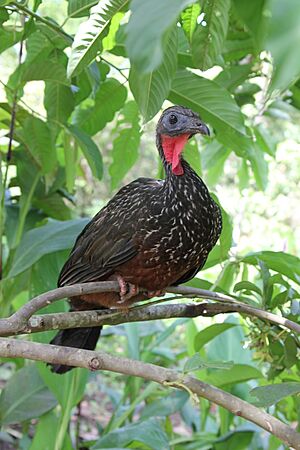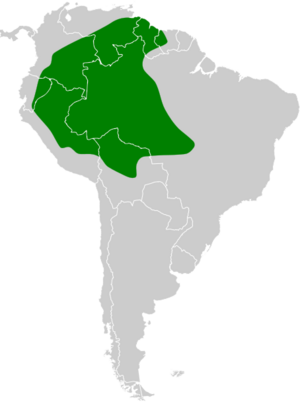Spix's guan facts for kids
Quick facts for kids Spix's guan |
|
|---|---|
 |
|
| In Manú National Park, Peru | |
| Conservation status | |
| Scientific classification | |
| Genus: |
Penelope
|
| Species: |
jacquacu
|
| Subspecies | |
|
|
 |
|
The Spix's guan (scientific name: Penelope jacquacu) is a type of bird that lives in the Amazon rainforest. It belongs to a bird family called Cracidae, which includes guans, curassows, and chachalacas. This bird is very common in the Amazon lowlands. It was named after a German scientist named Johann Baptist von Spix.
Contents
Types of Spix's Guan
Scientists recognize four different types, or subspecies, of Spix's guan. These are like different versions of the same bird. One type is called "Grant's guan." The other three are grouped together as "Spix's guan."
Sometimes, people thought Spix's guan was the same as other birds, like the dusky-legged guan or the crested guan. But now, they are known to be separate species.
What Does Spix's Guan Look Like?
The different types of Spix's guan look a bit different. They also have different weights. These birds are usually about 66 to 76 centimeters (26 to 30 inches) long.
The main type of Spix's guan, called P. j. jacquacu, has a bronzy olive-green color on its back. Its underside is a bright reddish color. Males of this type weigh about 1.24 to 1.36 kilograms (2.7 to 3 pounds). Females are a bit lighter, around 1.14 kilograms (2.5 pounds).
Another type, P. j. orienticola, is heavier. Males can weigh from 1.40 to 1.78 kilograms (3.1 to 3.9 pounds). Females weigh from 1.27 to 1.72 kilograms (2.8 to 3.8 pounds). "Grant's guan" is much darker than the others. It has a shiny blue-green color on its upper parts and a dark red underside.
Where Spix's Guan Lives
Spix's guan lives in parts of South America. You can find it in countries like Bolivia, Brazil, Colombia, Ecuador, Guyana, Peru, Suriname, and Venezuela. It lives near the upper Orinoco River and the western Amazon River basins.
These birds live in different kinds of forests. They can be found in terra firma forests, which are on higher ground. They also live in várzea forests, which get flooded during certain seasons. In higher places in Peru and Bolivia, they live in cloud forests. In lower areas, they prefer humid rainforests. These birds usually stay in the same area and do not migrate.
Spix's Guan Behavior
Reproduction and Life Cycle
Spix's guans lay eggs at different times of the year, depending on where they live. For example, in Venezuela, they might breed from January to May. In Peru, they might breed in August and September.
Only one nest has been described. It was made of leaves and was found about 5 meters (16 feet) high in a tree. We do not know how long the eggs take to hatch or when the young birds leave the nest.
What Spix's Guan Eats
Spix's guans usually look for food alone or in small family groups. They mostly find food in the middle and top parts of trees. But in some areas, they also look for food on the ground.
Their main diet is fruits and seeds. Sometimes, they have been seen following army ants. They do this to catch small insects and other creatures that the ants stir up.
Protecting Spix's Guan
The IUCN (International Union for Conservation of Nature) has listed Spix's guan as a species of "Least Concern." This means that it is not currently in danger of disappearing.
The area where these birds live is very large, about 5.9 million square kilometers (2.3 million square miles). They are common in many parts of this huge area. However, the total number of Spix's guans is not known, and it is thought to be going down. People often hunt these birds for food.
See also
 In Spanish: Pava amazónica para niños
In Spanish: Pava amazónica para niños


